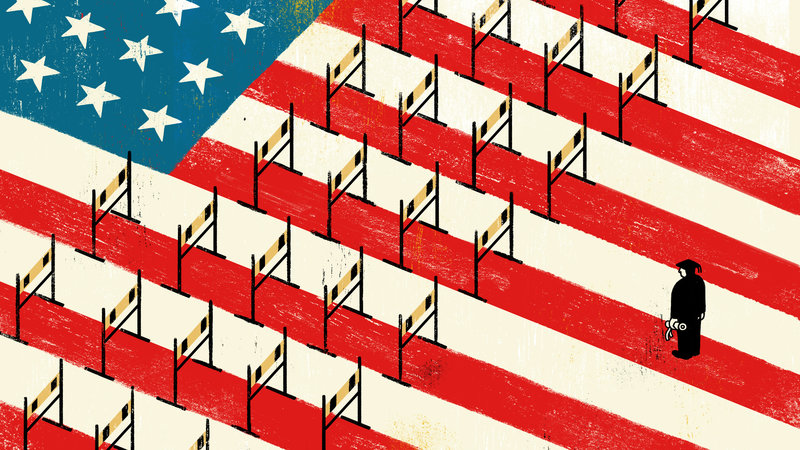Express Entry to Canada
Presented in Jan-2015, Canada’s Express Entry (EE) system was made to allow Canada to meet its future labor market needs to keep up long haul economic development. In 2020, the migration target was set at 195,800 through government financial projects, similar to those under the Express Entry System. This number is relied upon to increment as the year proceeds fundamentally. In 2020, Express Entry was assessed to give 91,800 Invitations to Apply (ITA’s) for lasting residency, which was outperformed, issuing a noteworthy 107,950 ITA’s.
Canada confidently proceeds to acknowledge and deal with Express Entry applications despite the current pandemic travel limitations. Moreover, Canada’s new immigration aggregates have been set for the following three years, promising to welcome over 1.2 million immigrants constantly in 2023.
The following is a breakdown of the 2021 – 2023 Express Entry Immigration targets:
- 2021 – 108,500 ITAs
- 2022 – 110,500 ITAs
- 2023 – 113,750 ITAs
What is the Express Entry System?
Canada’s Express Entry framework was presented by Immigration, Refugees and Citizenship Canada (IRCC), and it is utilized to choose contenders for immigration to Canada through different Federal Economic Immigration programs. Therefore, applicants who expect to apply for migration through the Federal Skilled Worker Class, Federal Skilled Trades Class, and Canadian Experience Class are needed to do as such through the framework.
As the primary driver of financial relocation to Canada, the Express Entry system is viewed as a lead program giving an optimized course to the Canadian movement. Therefore, we should look closely at how far Canada’s Express Entry Express has come, regardless of whether it satisfies its goals and how this affects you as a candidate.
Express Entry System’s History
- Express Entry to Canada: Application Process and Latest Express Entry Draws Result
- Comprehensive Ranking System
- Canada Immigration’s Plan: 2021 – 2023
Canadian Express Entry System’s History
Canada’s Express Entry system was introduced in January 2015 to help people apply for Canadian permanent residence under three categories:
- Federal Skilled Worker Program (FSWP);
- Federal Skilled Trades Program (FSTP); and
- Canadian Experience Class (CEC)
Early Rounds
Toward the start of 2015, most of the admissions came from applications submitted before January 1. This early Express Entry draws incorporated countless applications from foreign nationals who previously worked in Canada. In addition, many foreigners were given ITAs because they had offers for employment upheld by a Labor Market Impact Assessment (LMIA).
In the initial ten draws, which occurred more than a half year, a sum of 11,353 ITAs were given to applicants. Since the primary draw on January 21, 2015, the framework has formed Canada’s most professional immigration programs.
Remember that the number of welcomed competitors can be lower than the number of offers sent. This happens when a few candidates get more than one invitation or when invitations are declined.
System Improvements
Over the long run, the quantity of ITAs under the Express Entry system has kept rising because of Canada’s developing business sector. Because of this upwards pattern, enhancements were made to the framework in the fall of 2016.
These progressions happened on November 19, 2016. Pointed toward making a reasonable immigration framework, the progressions address human resource needs while guaranteeing long haul economic development for the country.
The enhancements incorporate granting points for employment opportunities made to qualified applicants effectively in Canada with LMIA-excluded work licenses and international students who have finished their schooling in Canada. Moreover, additional time is currently dispensed to submit applications for perpetual homes whenever they have gotten ITAs.
The latest improvement to Canada’s Express Entry framework is that applicants with excellent French language abilities can now get more points, expanding from 15 to 25 points for French speakers and 30 to 50 for bilingual candidates.
Job Offers
From November 19, 2016, Points Awarded by the CRS for a Job Offer Changed in Three Basic Ways:
- Points will be granted for offers for employment made to qualified candidates who are on LMIA absolved work permits. Numerous immigrant workers in Canada who are temporarily on a business explicit LMIA- exempt work license, yet who need to remain in Canada for all time, will presently don’t have to persuade an LMIA to be granted a proposition for employment points by the CRS. This incorporates applicants here under the North American Free Trade Agreement, a federal-provincial agreement, or intra-organization transferees. For the focus to be granted, the applicant should meet certain rules, for example, having, at any rate, one year of work experience from a similar business that is giving their proposition for employment.
- Offers for employment will be at least one year in term once they get permanent residence. Changing the proposition for employment necessity from permanent to one year implies that all the more exceptionally skilled applicants working in agreement-based businesses will have a higher probability of accepting an Invitation to Apply for permanent residence.
- Points granted for offers for employment will be diminished. For example, an aggregate of 50 points will be granted to candidates with a substantial offer for employment in a National Occupational Classification (NOC) 0, An, or B occupation. In comparison, a sum of 200 points will be granted to candidates with a legitimate offer for employment in a NOC 00 occupation.
80% of Express Entry applicants in 2017 got ITAs, even without an offer for employment. This implies that even without a bid for employment, it is as yet conceivable to meet all requirements for this program.
Education
Points will currently be granted for concentrating in Canada above secondary school. In addition, the CRS will grant 15 Points for a couple of years of recognition or testament and 30 Points for a degree, confirmation, or authentication of three years or more, including a master’s, professional or doctoral degree.
With these changes, more previous international students will want to progress to permanent residency utilizing the framework. International students’ understudies are a critical wellspring of contenders for the system in light of their age, instruction, abilities, and experience. For all time, coordinating into Canadian culture will be simpler for them since they have effectively acquainted themselves with life in Canada.
Applicants will currently have 60 days to finish an application for a perpetual home if they get encouragement to apply. This will give permanent residency more opportunity to accumulate all the necessary documentation and present a complete application.
Since the new changes happened, the quantity of ITAs issued has expanded, and the quantity of CRS points required has altogether diminished.
Express Entry to Canada ITA Numbers
1. Most numbers of ITAs issued in a single draw was 27,332 on February 13, 2021
2. Least number of ITAs issued in the single draw – 250 on January 6, 2021 (this draw was for applicants invited under provincial/regional nomination only)
3. Number of ITAs issued in 2015 were 31,063
4. Number of ITAs issued in 2016 were 33,782
5. Number of ITAs issued in 2017 were 86,022
6. Number of ITAs issued in 2018 were 89,800
7. Number of ITAs issued in 2019 were 85,300
8. Number of ITAs issued in 2020 were 107,950
9. Total number of ITAs issued to date in 2021 is 37,986
10. The total number of ITAs issued since the system was launched are 471,903
Why the Program Is Popular
Express Entry applications can take just a half year to measure, making this program one of the quickest immigration programs in Canada. Only migrants who have the correct right abilities needed in every region can qualify, not at all like the Green Card Lotteries utilized in the U.S.
Effective candidates residents can ultimately apply for permanent residency in Canada.
- Find out if you fit on the basic requirements;
- Make an online Express Entry Profile and make sure you have your:
- Passport
- Education credential assessment report;
- National Occupation Classification (NOC);
- Recent language tests:
- Test d’Evaluation de Français (TEF)
- International English Language Testing System (IELTS);
- Canadian English Language Proficiency Index Program
- (CELPIP); and/or
- Provincial Nomination (If you have one)
- Canadian employment offer (If you have one); and
- Get a CRS (Comprehensive Ranking System) score out a potential 1,200 focuses;
- Get an offer to Apply (ITA) if you score sufficiently high on the CRS. An ITA implies you can apply for a perpetual home in Canada:
Please be noted that the score expected to apply for perpetual home changes for each draw. Regardless of whether you don’t meet all requirements for a particular draw, you stay in the pool for one year.
- Pay an application charge and a Right of Permanent Residence Fee;
- Give Proof of Funds to show you can uphold your family;
- Give Police Certificates;
- Plan for a clinical test from confirmed wellbeing experts; and
- Contact past businesses to give work letters to demonstrate you have legitimate work insight
Kindly note that if you have a Canadian permanent for employment, your future employer may have to furnish you with an LMIA.
Comprehensive Ranking System
Candidates are positioned on a Comprehensive Ranking System (CRS) framework, which figures out who gets chosen from the Express Entry Pool first. This framework scores you dependent on four primary elements:
- Human Capital Factors;
- Spouse and Common Law Partner;
- Skill Transferability; and
- Additional Factors
These factors take into account:
- Age;
- Work experience;
- Education qualifications;
- Language skills;
- Adaptability;
- Job offers; and
- Spouse or common-law partner
The higher the candidates’ scores on the CRS, the better their odds of turning into permanent residents of Canada. The most elevated you can score on this framework is 1,200 points.
Underneath is a breakdown of how you can score:
- Core points = 600 points
- Additional points = 600 points
Core CRS Points
You can receive Core CRS points for the following:
- Skills and experience factors
- Spouse or common-law partner factors, e.g. language skills and Education; and
- Skills transferability, e.g., Education and working experience.
Additional CRS Points
You can receive additional CRS points for the following:
- Canadian Educational degrees, certificates or diplomas,
- A valid employment offer;
- A nomination from a province or territory;
- A sister or brother living in Canada (citizen or permanent resident.
- Strong French language skills.
| SECTION A – Core/Human Capital | ||
| Criteria | Maximum Points With Spouse | Maximum Points Without Spouse |
| Age | 100 | 110 |
| Education | 140 | 150 |
| Language Skills (English/French) | 150 | 160 |
| Canadian Work Experience | 70 | 80 |
CORE POINTS + ADDITIONAL POINTS = TOTAL SCORE
You can score points under these four main categories:
| SECTION B – Spouse or Common-Law Partner | |
| Criteria | Maximum Points |
| Education | 10 |
| Language Skills (English/French) | 20 |
| Canadian Work Experience | 10 |
| SECTION C – Skills Transferability | |
| Education | Maximum Points |
| Language Skills (English/French) + Education | 50 |
| Canadian Work Experience + Education | 50 |
| Foreign Work Experience | Maximum Points |
| Language Skills (English/French) + Foreign Work Experience | 50 |
| Foreign Work Experience + Canadian Work Experience | 50 |
| Certificate of Qualification (Trades) | Maximum Points |
| Language Skills (English/French) + Education Certificate | 50 |
| SECTION D – Additional Points | |
| Criteria | Maximum Points |
| Brother and Sister Living in Canada | 15 |
| French Language Skills | 30 |
| Post-Secondary Canadian Education | 30 |
| Arranged Employment | 200 |
| Provincial Nomination | 600 |
How to Improve Your CRS Score
There are different ways to improve your CRS scores, such as accepting a Provincial Nomination that adds an extra 600 points or finding a Canadian line of work offer worth 50 – 600 points. For instance, an offer for employment from a level 00 occupation under the National Occupation Classification (NOC) will give you an extra 200 points. Some other occupation level proposal from a Canadian employer will give you an extra 50 points. Be that as it may, an offer for employment under a Labor Market Impact Assessment (LMIA) will give 600 CRS points.
Another approach to expand your score is through Core Human Capital Factors (600 Points). This awards points for schooling capabilities like testaments, confirmations, and degrees. The higher your educational capabilities, the better the score you will get.
If you apply with your mate or common-law partner, it can likewise help increment your score, If they have valid work experience and educational foundation. Having more work experience can likewise affect CRS results.
Language abilities are an incredible method to expand CRS scores. The higher the candidates’ score on perceived French and English tests like IELTS, TEF, and CELPIP, the better the outcomes. Altogether, language abilities can add an extra 150 points.
Canada Immigration Plan: 2021 – 2023
In October 2020, the public authority of Canada delivered its Immigration Plan for the accompanying three years, looking to improve approaches to move to Canada by making the application cycle simpler and less tedious. Canada has kept on raising its immigration targets and plans to invite 401,000 immigrants in 2021. An aggregate of 108,500 is relied upon to apply for permanent residence through the Express Entry framework and around 80,800 through the Provincial Nominee Program (PNP). These sums are relied upon to increase 1,000 ITAs consistently to 411,000 every 2022 and 421,000 out of 2023. The following is a breakdown of the Government plan for Economic Immigration for 2020.
| Economic Canadian Immigration Plan for 2021 | |
| Immigration Program | Target |
| Express Entry | 108,000 |
| Provincial Nominee Program | 80,800 |
| Quebec Immigration | TBC |
| Economic Pilot’s (Caregivers; Agri-food Immigration Pilot; Rural and Northern Immigration Pilot) | 8,500 |
| Atlantic Immigration | 6,000 |
| Business Immigration (Start-up Visa and Self-employed Persons Program) | 1,000 |
| Total (Economic) | 232,500 |


